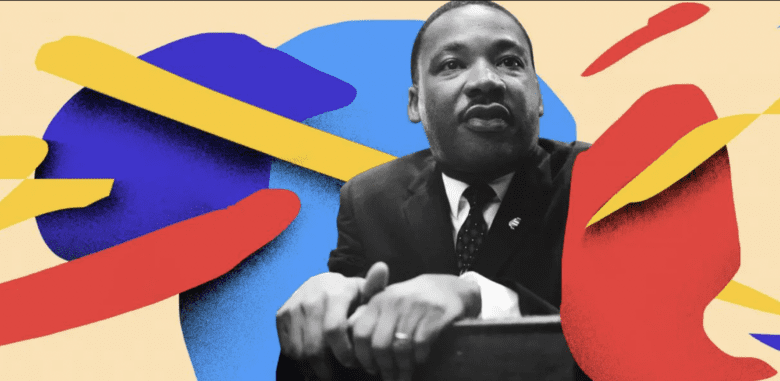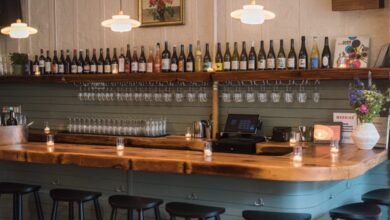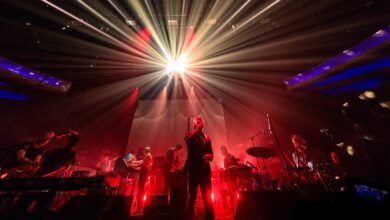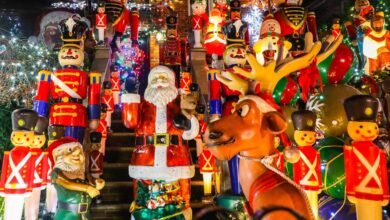MLK in NYC: ‘Down the path of protest and dissent’


Martin Luther King Jr. is most closely associated with the South. It’s where he was from and it was where he did his most vital work. But King was also deeply connected to New York City. He visited churches, gave speeches, appeared at the United Nations, met with the Mayor Robert F. Wagner Jr., and worked with the homegrown network of activists here.
“He used the city as a launching pad for media appearances, televised debates, press conferences,” said Sarah Seidman, the Puffin Foundation Curator of Social Activism at the Museum of the City of New York, in a 2021 interview with Brooklyn Magazine about King’s relationship to the city. “He met with mayor Wagner after the riot in the city in ’64, knew the importance of the city as a media capital, but also as a gateway to the work in the postwar period and its roles a global city.”
In April of 1967 he delivered his “Beyond Vietnam” speech at Riverside Church in the city — and “was totally lambasted,” said Seidman, for condemning the war as anti-democratic, impractical, and unjust.
“If America’s soul becomes totally poisoned, part of the autopsy must read: Vietnam,” said King. “It can never be saved so long as it destroys the deepest hopes of men the world over. So it is that those of us who are yet determined that America will be are led down the path of protest and dissent, working for the health of our land.”
To celebrate and honor the legacy of Martin Luther King Jr., we’re re-sharing excerpts from this podcast interview with Seidman, who curates the ongoing exhibition Activist New York, which explores nearly 400 years of activist histories in New York City.
Here, she discusses not only about King’s relationship to the city, but the city’s wider role in the civil rights struggle—through the Bed-Stuy Brooklyn Chapter of C.O.R.E., the Congress of Racial Equality, and the career of Rep. Shirley Chisholm, up to the Black Lives Matter demonstrations at Barclays Center in the aftermath of the George Floyd and Breonna Taylor murders at the hands of police.
The following is a transcript of our conversation, which originally aired as an episode of “Brooklyn Magazine: The Podcast,” edited for clarity.
Martin Luther King Jr. is connected to the city in ways that not a lot of people realize. Most Americans know about King’s “I Have A Dream” speech, famously delivered on the Mall in Washington, but many have not heard or read his “Beyond Vietnam” speech, which was delivered here in New York. I figured that might be a good place to start.
It’s been one of the most exciting — amidst many exciting projects I’ve gotten to work on as a curator at the Museum of the City of New York — to delve more into King’s role in the city, having known a lot about him in my own training, but not as much about his work in New York City. So certainly, he used the city as a launching pad for media appearances, televised debates, press conferences. He met with Mayor Wagner after the riot in the city in ’64, knew the importance of the city as a media capital, but also as a gateway to the world in the post-war period and its role as a global city after World War II. So being at the U.N., really connecting his own interest in human rights on the global scale with the Civil Rights and Black Freedom Movement in the United States and New York’s role in facilitating those connections. So his speech at Riverside Church around the Vietnam War is perhaps the most striking example of that.
What can you tell us about that speech? What was said, what was the climate in New York? Talk about that moment when he was here in the city and what the goal of that particular speech was.
There’d been many groups in the Black Freedom Movement who had spoken out about the Vietnam War and the U.S. role in it before King. S.N.C.C., the Student Nonviolent Coordinating Committee in particular, and people had been urging him to speak out against the war, maybe knowing his personal views against the war, but there were also folks on the other side urging him not to, that it would be too risky for his Civil Rights stance.
It would confuse the message? Was that the concern?
Certain skeptics thought, “What does civil rights in the United States have to do with the global arena?” For King, they were always connected deeply. From Gandhi being a role model for King and inspiration, to his great interest in the decolonization and independence of African countries in the late ‘50s and early ‘60s. And that was another connection to the U.N. and what was happening at the U.N. and New York. So for King, the connection was totally natural. And then there were those urging him to take that stance in S.N.C.C., the Student Nonviolent Coordinating Committee, which had come out against the war in early 1966.
So finally, he decided to make the speech at Riverside Church on April 4th, 1967. He had started to speak out against the war a little bit before then, but that was his real public declaration, a historic speech, really incredible text that connects both why the war was bad for the Civil Rights Movement, African-Americans serving and dying disproportionately, funds being taken away from The Poor People’s Campaign as well as broader questions of human rights and equality and what it meant for Americans to fight against a non-white peoples trying to assert their independence in Vietnam.
A couple of years later, you had Muhammad Ali famously conscientiously objecting to the war, which was more of a high octane pop culture figure connecting those dots.
It definitely was a watershed moment as the tide was turning from a smaller anti-war opposition to a larger mass movement by ’68, ’69 definitely. But at the time, King was totally lambasted. The New York Times printed a scathing editorial against him and L.B.J. pretty much stopped talking to him after that. So he did face real consequences from his anti-war stance that I think in some ways is hard to even grasp a little bit now. So it was certainly a brave and important move that contributed to the anti-war effort. And he came back about 10 days later to march in the largest anti-war protest to date, which was in New York and also San Francisco on April 15th, 1967. And there are wonderful photographs in the museum’s collection as well as elsewhere of the march that day.
Activist efforts in New York actually stretch back to the very beginning of New York — back to the struggle for religious tolerance in New Netherland back in the 17th century — right up until now. The N.A.A.C.P. was founded in New York City in 1909. What are you thinking about this week, both with the historic context, which you’re so familiar with and what’s continuing to be happening today?
It’s certainly an overwhelming moment, and I don’t know if I’ve reached mental clarity about it, but certainly as a historian, connecting past with present and being struck by calls for unity and the idea that this is not who we are, but seeing such a strong connection to longstanding and continuous violence around racism and freedom and the results in Georgia happening the same day as the attack on the Capitol seems very connected, and that historic Senate win.
I’ve been digging into inauguration history a little more than I usually do, being someone who focuses usually on social movements, but thinking about, and the Museum of the City of New York has, we’ve been examining some materials relating to Marian Anderson in our collection, and she sang at the 1957 inauguration of Eisenhower, actually, and then again at J.F.K.’s in 1961. So thinking about that, her historic performance as the first Black performer at an inauguration ceremony, but also African-Americans being invited to participate in the Inauguration Parade in 1865. So pathbreaking moments, but ones that also were so related to racialized violence. It’s kind of a jumble, but definitely connecting past and present and knowing how much work there is to go to face the unresolved histories really of the Civil War and slavery, and going back to our founding and the work that needs to be done.
People have been saying in the wake of recent racial violence, “This is not who we are.” But it’s very clearly a big part of who we are. Talk about that march more, in 1865 inauguration.
It’s Lincoln’s second inaugural, and he invited African-American participation in the parade. But that was the first time that there had been an official Black presence at an inaugural event in the Capitol. And when Marian Anderson sang in ’57, Washington D.C. had recently just been officially desegregated. The role of D.C. and the nation’s capital, the seat of power and what that has always meant for African-Americans is certainly important.
You can’t really talk about activism in New York without talking about, very specifically, the Brooklyn chapter of the Congress of Racial Equality, C.O.R.E., which was based in Bed-Stuy in the ’60s. Can you tell us what you know about C.O.R.E., both at a national level and how they agitated and activated locally here in Brooklyn? I certainly have a few examples I can rattle off, but who is C.O.R.E. nationally and what did they do here in Brooklyn?
Congress of Racial Equality is a national group that was founded, I think, in the ‘40s, and they did great work all over the place. But the Brooklyn chapter is certainly so notable and really inspiring in the work that they did in the early ‘60s. Brian Purnell’s book dedicated to this topic [“Fighting Jim Crow in the County of Kings”] is a must read for any Brooklynite, because it just goes into such amazing detail with the behind the scenes work of activism that we don’t always get to see. You see the demonstrations. They certainly demonstrated against Sealtest [Dairy], employment discrimination, around schools segregation. Brooklyn activists were really at the forefront of that — Milton Galamison and teachers and parents and students who boycotted public schools in 1964.
So certainly C.O.R.E. was kind of involved with that. And then they kind of tapered off a little bit by mid-decade in the city. But I remember particularly their campaign against housing discrimination was so striking to me where they send white members of the group. It was very interracial, at least for several years, until those conversations came to the fore about who should be leading Brooklyn C.O.R.E. and these groups in general. But white members were sent to fill out apartment applications, accepted, and then they would go back with Black members and be turned away and say, “Oh, there’s no vacancies.” Or, “Sorry, your application was rejected.” Seeing that hard, laborious, tedious work really made an impression on me about how activism works behind the scenes.
They effectively deployed the boycott as a tool as well. For example, in the Sealtest boycott where something like less than 1 percent of the employees at Sealtest were people of color, Black or Puerto Rican. And you hear about boycotts today, maybe not having quite the effect that this did, but it did open the door for more integration at the company. Can you talk about that a little bit and the use of the boycott and/or Sealtest specifically?
One of the big takeaways also from those actions in addition to the effective tool of boycotting, which we have seen in numerous instances, is that there was real legal discrimination in New York. Right? You said earlier, we think of the Civil Rights Movement, Martin Luther King being based in the South, but there were all kinds of laws and policies essentially that prevented African-Americans from equal access and opportunities in New York City. So we see something like that, where there’s employment discrimination that’s pretty blatant. And then even after it’s dismantled, you see the after effects of it and the de facto segregation also, and how those things just linger.
One example that we talk about in activist New York, not Brooklyn, but Stuyvesant Town and how it was legally segregated in the beginning and even after a grassroots campaign to let Black families in, which did happen a few years later. Has Stuyvesant Town ever really fully integrated, I think is a valid question. So you see the long-term effects as well as the efforts to dismantle these policies and laws.
You can change the curtains maybe, but the bones persist. The museum worked with the Brooklyn Public Library quite a bit, digging into their archives. Any surprises there? Anything that you didn’t know or that you were pleased to learn or disappointed to learn?
There’s a lot of great newspaper coverage and reading how people were documenting the events of the time at that moment was always useful and interesting, as well as photographs of the interracial families who resisted having to send their kids to one school rather than another. And then, I’ve also done educator workshops, the Brooklyn Collection there. So that was a fun kind of collaboration between the museum and the Brooklyn Library around those histories. And certainly what’s in archives matters for accessing history and then being able to tell those stories in the museums, any efforts by archives to highlight those stories and collect materials past or present. And we’re in the midst of that too, collecting materials from this moment and from the uprising of the summer and fall and the movement for Black Lives. So certainly can’t emphasize that enough. How important accessing these archival materials are to telling these stories.
How do you approach the current moment with a historian’s eye? How do you both experience what’s happening in real time, but also make sure that you’re properly preserving or documenting it for history’s sake? How do you also pay attention to your own language or framing? Because I imagine as you’re going through the archives, a lot of the way that these discussions were framed probably feel pretty antiquated or archaic. How do you live in a moment, but also bookmark it for history in a way?
It’s definitely a dual approach as just a person, but also a historian or historical thinker. And I think it can be tricky to know exactly what will be the most lasting objects. I certainly have some ideas. Masks, one clear example, as well as protest signs from some of the events of the summer. We’ve gotten a lot of donation offers, and that’s something that we’re very interested in. But I think also, right, getting back to C.O.R.E. and just connecting past and present, realizing the long work and behind the scenes work that these activists that burst onto the scene after George Floyd’s killing, they’ve been there and they’ve been doing that work.
I was listening to a talk with Angela Davis, who has her own New York City history dating back decades, but she was talking about how the mobilizations are the culmination of decades of activist work. And I think that is really important to remember as well, that this isn’t right, this isn’t new. And the boycotts, the demonstrations, the lobbying that can all become more visible at a certain moment, but at the hard work is continuous.
Another woman closely associated with New York and Brooklyn specifically is Shirley Chisholm. Brooklyn-born, a contemporary of King’s. She’s recently gotten more of her due. Can you talk about her impact and influence if you haven’t been to the state park named after her down south in southern Brooklyn? It’s really pretty.
It’s so exciting that she has a monument now. I love the public recognition and the ways the city is memorializing Shirley Chisholm, she’s such an important figure, the first Black congresswoman and then Black woman to mount serious campaign for president in 1972. And she certainly is foundational for generations of Brooklyn politicians, certainly as well as nationally women of color who are inspired by her, certainly Kamala Harris among them.
She featured prominently in a show we did at the museum a few years ago, “Beyond Suffrage,” a century of women in politics that looked at the connections between women running for office and being in elected office, as well as working behind the scenes in government and through grassroots activism. And certainly, she did all of those. I hadn’t realized that she ran Merrill for a few years. So certainly she’s an inspiring grassroots activist as well as elected official, and I’m so glad that we’re talking about her more and more. And I think the centennial of her birth is coming up in the next few years. I think we’ll see even more of her.
Prospect Park is getting a monument to her at one of the entrances. Her work is not done. Talk about yourself. What is your own background? You’re in Manhattan, you spent some time in Brooklyn. What was it that drew you to social activism?
In my own historical training, looking at hidden or obscured histories and exploring them and then through my work at the museum, trying to make them as accessible to broad audience as possible has been my own approach to social justice work. Certainly not on the front lines, but digging into the archives and working with community members whenever we can through listening groups on certain topics that we’re mounting exhibitions on at the museum to soliciting donations and materials. So being able to work with folks who are on the front lines is certainly exciting.
But my background is in American studies and museum studies, and being able to marry those things through a New York City lens is a dream come true. All my family immigrated here. I live in the Lower East Side now where my great-great grandparents lived. So after a brief and enjoyable stint in Brooklyn, I’m back in Manhattan among my ancestral homeland, basically. But I spent a few years in Gowanus and I love Brooklyn as well.
Favorite New York Museum?
The Museum of the City of New York, of course.
Favorite museum in New York that is not the City of New York Museum?
I love the work of The Whitney, connecting U.S. history to art.
Must-read historic tract?
Angela Davis’s work, from her own autobiography, to women, race, and class.
Favorite historical period to study?
The ‘60s, definitely.
If you could go back in time, period of time you would most want to live in?
I think I’m happy with now. It’s certainly a busy period that we’re in right now.
The post MLK in NYC: ‘Down the path of protest and dissent’ appeared first on Brooklyn Magazine.
Source link





